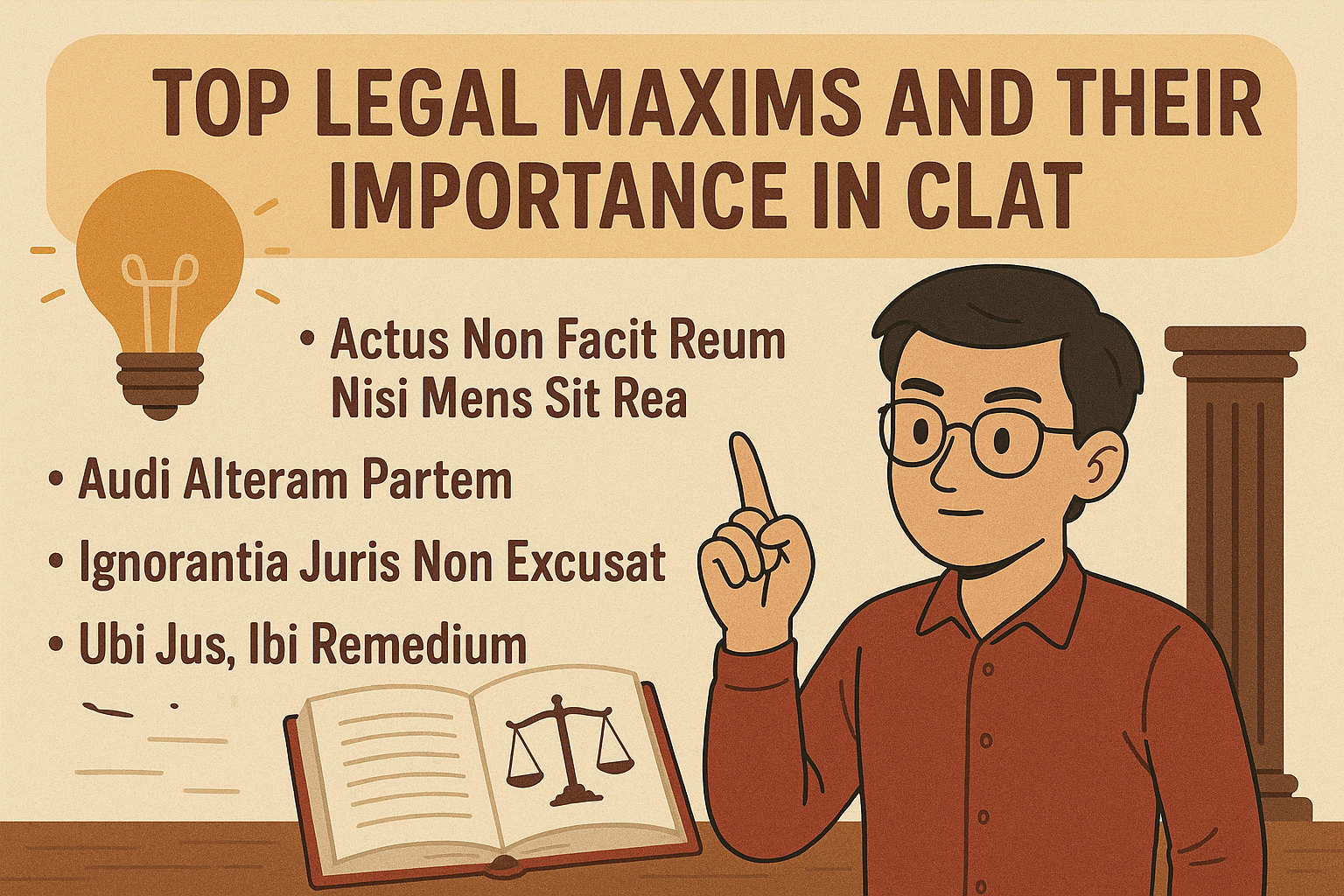Boost Your Legal Reasoning Score with Must-Know Legal Phrases
Legal maxims are short Latin phrases or established legal principles that encapsulate key aspects of law. In CLAT (Common Law Admission Test), legal maxims are extremely important—especially in the Legal Reasoning and Current Affairs sections. Understanding these maxims can enhance your ability to interpret legal principles, solve passage-based questions, and perform better in legal aptitude assessments.
In this article, we will cover the top legal maxims for CLAT, explain their meanings and applications, and discuss how to study them effectively. A FAQ section is included at the end for your reference.
What Are Legal Maxims?
Legal maxims are concise statements of law or principles derived from Latin, which have been recognized through centuries of use in legal systems across the world. They help in interpreting statutes, constructing arguments, and understanding judgments.
In the CLAT exam, these maxims are either:
Directly tested through definition-based questions
Indirectly embedded in passage-based legal reasoning questions
Why Are Legal Maxims Important for CLAT?
CLAT Legal Reasoning often includes situations based on principles expressed in these maxims
Understanding maxims helps quickly identify the core legal concept in lengthy passages
Some maxims appear in previous years’ question papers, making them high-priority for revision
Helps in legal writing and analysis during law school interviews and internships later on
Top 25 Legal Maxims to Learn for CLAT 2025
| Legal Maxim | Meaning |
|---|---|
| Ignorantia juris non excusat | Ignorance of the law is no excuse |
| Actus non facit reum nisi mens sit rea | An act does not make one guilty unless the mind is also guilty |
| Nemo debet esse judex in propria causa | No one should be a judge in their own case |
| Audi alteram partem | Hear the other side |
| Res ipsa loquitur | The thing speaks for itself |
| Volenti non fit injuria | No injury is done to a consenting person |
| Ubi jus ibi remedium | Where there is a right, there is a remedy |
| Qui facit per alium facit per se | He who acts through another acts himself |
| Caveat emptor | Let the buyer beware |
| Caveat venditor | Let the seller beware |
| Injuria sine damno | Legal injury without actual damage |
| Damnum sine injuria | Actual damage without legal injury |
| Mens rea | Guilty mind |
| Modus operandi | Method of operation |
| Stare decisis | To stand by things decided (precedent) |
| Obiter dicta | Things said in passing (not binding) |
| Ratio decidendi | Reason for the decision (binding part of a judgment) |
| Ex post facto | From a thing done afterwards (laws applied retroactively) |
| Habeas corpus | You shall have the body (a writ to present the detained person) |
| Prima facie | At first glance |
| Locus standi | Right to be heard or right to appear |
| Ultra vires | Beyond the powers |
| Sub judice | Under judicial consideration |
| Mutatis mutandis | With necessary changes |
| De facto / De jure | In fact / In law |
How to Study Legal Maxims for CLAT
Make Flashcards
Create physical or digital flashcards with the maxim on one side and the meaning with an example on the other.
Use in Context
Understand and use the maxims in legal problems and mock tests to strengthen retention.
Group Study
Discuss and quiz each other with friends. Explaining aloud improves memory.
Weekly Revision
Make a list of 50 to 100 legal maxims and revise 10 each day. Reserve one day weekly for revision.
Benefits of Learning Legal Maxims for CLAT
Better understanding of legal passages
Faster elimination of wrong options in MCQs
Improved comprehension of legal current affairs
Enhances legal reasoning and argumentation skills
SEO Keywords to Use in Your Prep or Content
legal maxims for CLAT
important legal maxims and meanings
CLAT legal reasoning tips
Latin phrases used in law
must-know legal terms for CLAT
how to prepare legal reasoning for CLAT
legal maxim examples for CLAT exam
Frequently Asked Questions (FAQs)
Q1. Are legal maxims directly asked in CLAT?
Not directly in recent years, but they are often part of principle-based legal reasoning passages.
Q2. How many legal maxims should I learn for CLAT?
Focus on 50 to 100 frequently used legal maxims that have appeared in mocks or coaching materials.
Q3. What is the best source to learn legal maxims?
Use trusted CLAT preparation books, coaching notes, or legal education websites.
Q4. Can legal maxims appear in Current Affairs or GK section?
Yes, especially in questions involving judgments, constitutional updates, or new laws.
Q5. Are these maxims useful after CLAT as well?
Absolutely. They are widely used in law schools, internships, and court judgments.
Conclusion
Learning legal maxims for CLAT is not just about rote memorization. It’s about understanding the logic of law. These timeless phrases will help you decode questions in the legal reasoning section and build a strong foundation for your legal studies. Start early, revise often, and focus on applying them practically while solving questions.






